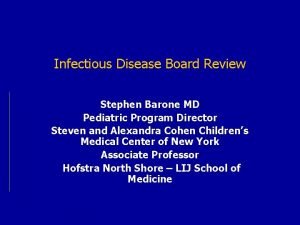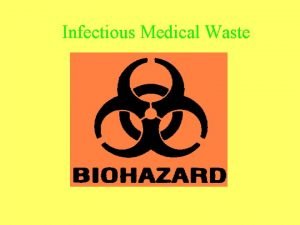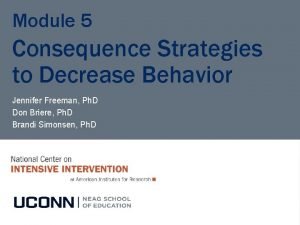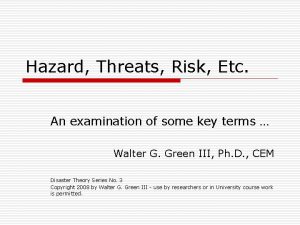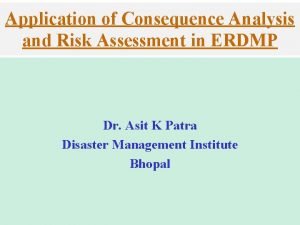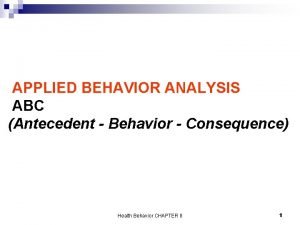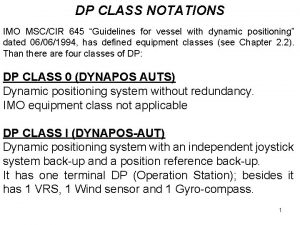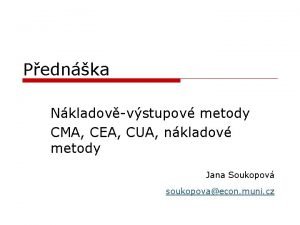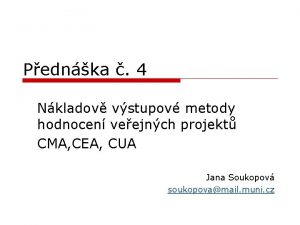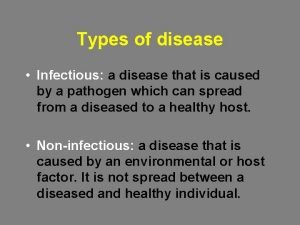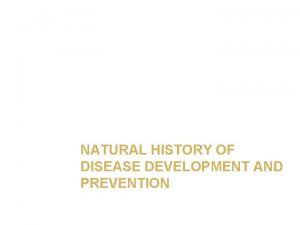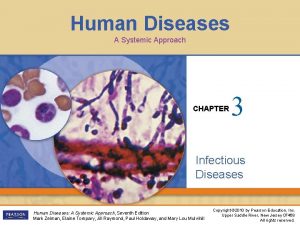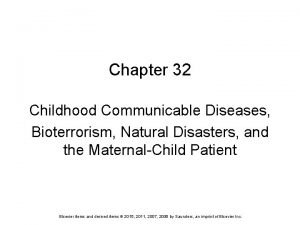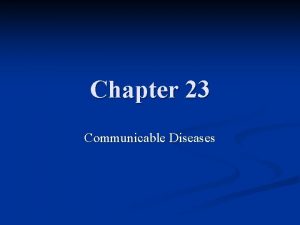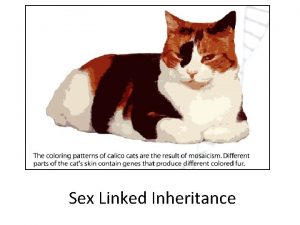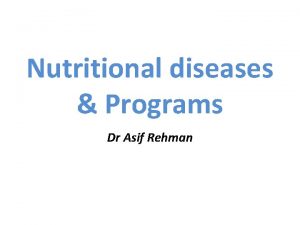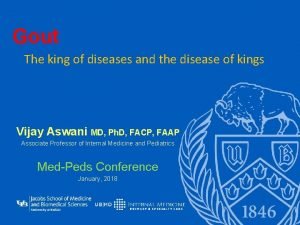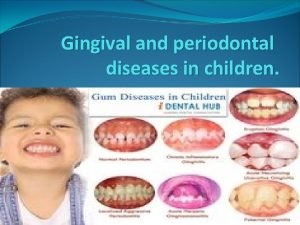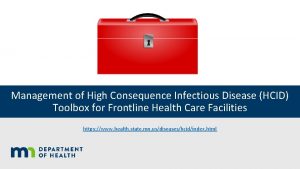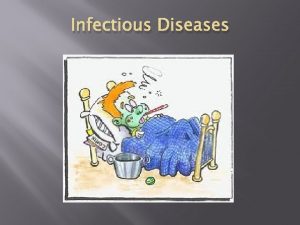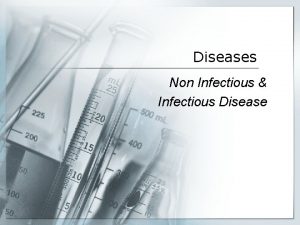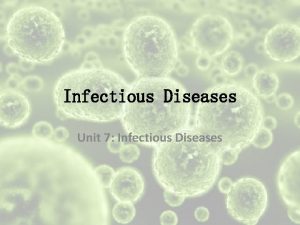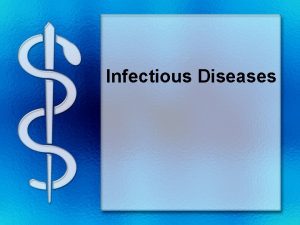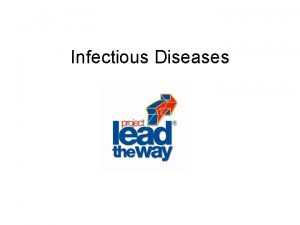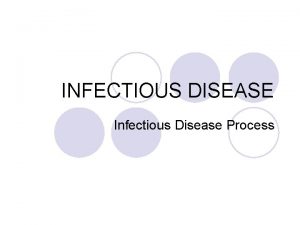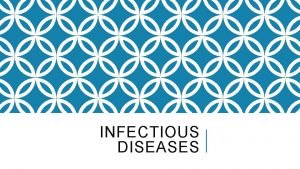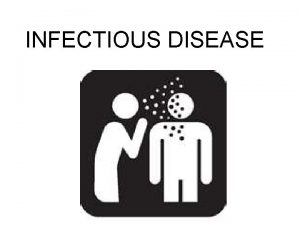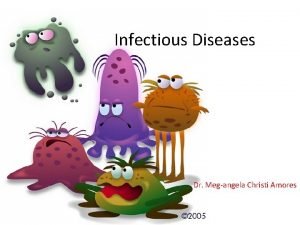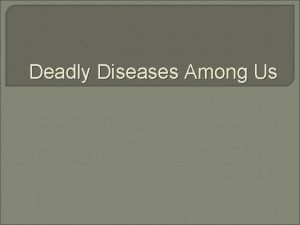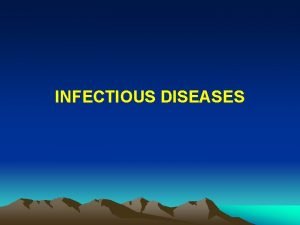High Consequence Infectious Diseases HCID Disease Specifics High






































































- Slides: 70

High Consequence Infectious Diseases (HCID) Disease Specifics

High Consequence Infectious Diseases • Middle East Respiratory Syndrome (MERS) • Ebola Virus Disease (EVD) • Marburg hemorrhagic fever (Marburg HF) • Lassa Fever • Crimean-Congo Hemorrhagic Fever (CCHF) • Nipha Virus (Ni. V) • Monkeypox

Patient Screening • All patients should be screened for • Respiratory symptoms • Fever • Rash • Travel history in last 30 days • Screening all patients will aid in identifying a high consequence infectious disease (HCID) or other contagious illnesses such as measles, chickenpox, and influenza

HCID Definition A high consequence infectious disease (HCID) is defined by the Minnesota HCID Collaborative* as a disease that: • All forms of medical waste are classified as Category A infectious substances (UN 2814) by the U. S. Department of Transportation or • Has potential to cause a high mortality among otherwise healthy people and • no routine vaccine exists and • some types of direct clinical specimens pose generalized risks to laboratory personnel or • risk of secondary airborne spread or unknown mode of transmission * MN HCID Collaborative: MN Department of Health, Mayo Clinic, University of Minnesota Medical Center, Minnesota Hospital Association, Minnesota Health Care Coalitions, Minnesota HCID-Ready EMS services

Syndrome HCID for which no routine vaccine currently available HCID For Which No Routine Vaccine is Currently Available Pathogen Examples Unknown highly fatal disease with evidence of person-to-person spread Hemorrhagic fever Ebola virus, Marburg virus, Lassa virus, Crimean-Congo virus, Guanarito virus, Machupo virus, Junin virus, Sabia virus, Lujo virus, Chapare virus, Kayasnur Forest Disease, Omsk Hemorrhagic Fever, Hantaviruses causing HFRS Poxvirus diseases Category A Generalized laboratory risk from Risk of airborne spread in healthcare waste direct clinical specimens settings or unknown mode of transmission Yes Yes Yes/No (none are known to be transmitted via airborne spread, but all potential modes of transmission may be unknown for some rare pathogens) Variola (smallpox) virus, Monkeypox Yes Yes Febrile neurological or respiratory illness Nipah virus, Hendra virus Yes ? Yes (Nipah virus only) Febrile respiratory illness MERS-Co. V, SARS-Co. V, Pandemic Influenza No No Yes

HCID Screening Guidance • A suggested framework to aid with the Identify, Isolate, and Inform components of HCID preparedness • Impact not limited to HCIDs; designed to prevent spread of both common and are rare infections • Emphasizes respiratory etiquette • 4 short questions for all patients • 1 additional question in some circumstances

Assessed by Front Desk or Triage Nurse

Assessed by Front Desk or Triage Nurse: Fever

Assessed by Provider (purple and yellow areas)

Assessed by Provider

If HCID suspected – do the following • Place appropriate isolation signage at the patient’s door • Evaluate persons accompanying the patient for illness and/or exposure to a HCID • Track all health care providers (HCP) who have had contact with the suspected HCID patient for potential exposure • Track all the HCP who have entered the patients room for potential exposure • Clinical staff should contact the laboratory leadership regarding sending specimens to the facility’s clinical laboratory

Middle East Respiratory Syndrome (MERS) CDC: Middle East Respiratory Syndrome (MERS) (https: //www. cdc. gov/coronavirus/mers/index. html) WHO: Middle East respiratory syndrome coronavirus (MERS-Co. V) (https: //www. who. int/emergencies/mers-cov/en/)

History of MERS-Co. V Infection • Middle East Respiratory Syndrome (MERS) is caused by a virus called Middle East Respiratory Syndrome Coronavirus (MERS-Co. V). Most MERS patients develop severe acute respiratory illness with symptoms of fever, cough, and shortness of breath. About 3 to 4 out of every 10 patients reported with MERS have died. • Health officials first reported the disease in Saudi Arabia in September 2012. Through retrospective (backward-looking) investigations, health officials later identified that the first known cases of MERS occurred in Jordan in April 2012. So far, all cases of MERS have been linked through travel to, or residence in, countries in and near the Arabian Peninsula. • The largest known outbreak of MERS outside the Arabian Peninsula occurred in the Republic of Korea in 2015. The outbreak was associated with a traveler returning from the Arabian Peninsula. There was a total of 186 cases which occurred primarily due to transmission in health care facilities. The case fatality rate was 44%. 1 • MERS-Co. V has spread from ill people to others through close contact, such as caring for or living with an infected person. 1 Park J, Lee K, et al. Hospital Outbreaks of Middle East Respiratory Syndrome, Daejeon, South Korea, 2015. Emerg Infect Dis. 2017; 23(6): 898 -905.

About Middle East Respiratory Syndrome (MERS) Screen all patients for: • • • Respiratory symptoms Fever Rash Travel history in last 30 days Screening all patients will aid in identifying an HCID or other contagious illnesses such as measles, chickenpox, and influenza Symptoms • Fever, cough, shortness of breath - may have diarrhea and nausea/vomiting, sore throat, coryza, headache, dizziness, abdominal pain • In severe cases pneumonia and kidney failure • Some have mild illness (like a cold) or no symptoms • People with pre-existing conditions may be more likely to be infected or have a severe case Causative agent • Coronavirus called Middle East Respiratory Syndrome Coronavirus (MERS-Co. V)

About MERS continued Reservoir • Humans and camels • Source is likely an animal source in the Arabian Peninsula Incubation period • Usually about 5 -6 days, but can range from 2 -14 days Transmission • Close contact • Thought to spread from an infected person’s respiratory secretions such as through coughing • The precise ways the virus spreads are not currently well understood Diagnosis • For suspect case, contact MDH at 651 -201 -5414 or 1 -877 -676 -5414 • MDH can perform testing for MERS-Co. V • Specimens for testing: lower respiratory specimen, NP swab and serum

MERS Management and Treatment Lab Specimens • Follow standard laboratory practices using Standard Precautions for potential MERS-Co. V specimens • Specimens are Category B per Department of Transportation. Must package appropriately for transport. Management of contacts • Identify persons at risk for contact with patient: staff, other patients, visitors • Evaluate persons who accompany the patient for symptoms of MERS • Develop plan with the state and federal authorities for monitoring exposed persons and facility staff • Monitor exposed persons for 14 days for symptoms of MERS Treatment • There is no specific antiviral treatment recommended for MERS-Co. V infection. Individuals with MERS often receive medical care to help relieve symptoms. For severe cases, current treatment includes care to support vital organ functions.

MERS Isolation Precautions Isolation • Clinical symptoms and epidemiologic risk should be met to designate a patient under investigation (PUI) for MERS – CDC: MERS Interim Guidance for Healthcare Professionals (https: //www. cdc. gov/coronavirus/mers/interim-guidance. html) • Place face mask (not N 95) on any patient with respiratory symptoms • Place patient in airborne infection isolation room (AIIR) as soon as possible • Hand hygiene, personal protective equipment (PPE): gloves, gown, N 95 or PAPR, eye protection • Identify others at risk for exposure (persons accompanying patient, other patients, visitors) • Limit transport of patient around facility • Only essential persons should enter room. Consider using phone or intercom for communication with patient. • Length of isolation determined on a case-by-case basis with consult from state and federal health authorities

MERS and Infection Prevention and Control Cleaning • Standard cleaning and disinfection procedures are appropriate for MERS-Co. V in health care settings, including those patient-care areas in which aerosol-generating procedures are performed. If there are no available EPA-registered products that have a label claim for MERS-Co. V, products with label claims against human coronaviruses should be used according to label instructions. Waste • Management of laundry, food service utensils, and medical waste should also be performed in accordance with routine procedures Prevention • No vaccine • Protect from respiratory diseases in general: hand hygiene, respiratory etiquette

Patient Under Investigation (PUI) Definition MERS A. Fever 1 AND pneumonia or acute respiratory distress syndrome (based on clinical or radiologic evidence) AND EITHER: • history of travel from countries in or near the Arabian Peninsula 2 within 14 days before symptom onset, OR • close contact 3 with a symptomatic traveler who developed fever and acute respiratory illness (not necessarily pneumonia) within 14 days after traveling from countries in or near the Arabian Peninsula 2, OR • a member of a cluster of patients with severe acute respiratory illness (e. g. , fever 1 and pneumonia requiring hospitalization) of unknown etiology in which MERS-Co. V is being evaluated, in consultation with state and local health departments, OR B. Fever 1 AND symptoms of respiratory illness (not necessarily pneumonia; e. g. , cough, shortness of breath) AND being in a healthcare facility (as a patient, worker, or visitor) within 14 days before symptom onset in a country or territory in or near the Arabian Peninsula 2 in which recent healthcare-associated cases of MERS have been identified. OR C. Fever 1 OR symptoms of respiratory illness (not necessarily pneumonia; e. g. cough, shortness of breath) AND close contact 3 with a confirmed MERS case while the case was ill. Footnotes are on subsequent slide

Confirmed and Probable Case Definition MERS-Co. V • Confirmed Case • A confirmed case is a person with laboratory confirmation of MERS-Co. V infection. Confirmatory laboratory testing requires a positive PCR on at least two specific genomic targets or a single positive target with sequencing on a second. • Probable Case • A probable case is a PUI with absent or inconclusive laboratory results for MERS-Co. V infection who is a close contact 3 of a laboratory-confirmed MERS-Co. V case. Examples of laboratory results that may be considered inconclusive include a positive test on a single PCR target, a positive test with an assay that has limited performance data available, or a negative test on an inadequate specimen. Footnotes are on subsequent slide

MERS PUI Definition Footnotes 1. Fever may not be present in some patients, such as those who are very young, elderly, immunosuppressed, or taking certain medications. Clinical judgement should be used to guide testing of patients in such situations. 2. Countries considered in the Arabian Peninsula and neighboring include: Bahrain; Iraq; Iran; Israel, the West Bank, and Gaza; Jordan; Kuwait; Lebanon; Oman; Qatar; Saudi Arabia; Syria; the United Arab Emirates (UAE); and Yemen. 3. Close contact is defined as a) being within approximately 6 feet (2 meters), or within the room or care area, of a confirmed MERS case for a prolonged period of time (such as caring for, living with, visiting, or sharing a healthcare waiting area or room with, a confirmed MERS case) while not wearing recommended personal protective equipment or PPE (e. g. , gowns, gloves, NIOSH-certified disposable N 95 respirator, eye protection); or b) having direct contact with infectious secretions of a confirmed MERS case (e. g. , being coughed on) while not wearing recommended personal protective equipment.

Middle East Respiratory Syndrome Coronavirus (MERS-Co. V) Overview Disease & Agent Geographic Areas Transmission Incubation period Signs & Symptoms Mortality rate Diagnostic Testing Prevention & Treatment Isolation & PPE Cleaning Specimen transport and waste Middle East Respiratory Syndrome (MERS) is caused by Middle East Respiratory Syndrome Coronavirus (MERS-Co. V) Linked to travel in and near the Arabian Peninsula Close contact Usually about 56 days but can range from 2 -14 days Fever, cough, shortness of breath - may have diarrhea and nausea/vomiting, sore throat, coryza, headache, dizziness, abdominal pain About 3 to 4 out of every 10 patients reported with MERS have died Specimens for testing: lower respiratory specimen, NP swab and serum There is no specific antiviral treatment recommended for MERS-Co. V infection Place facemask (not N 95) on any patient with respiratory symptoms Standard cleaning and disinfection procedures Transport specimens as Category B infectious waste If available EPA registered products do not have a label claim for MERSCo. V, products with label claims against human coronaviruses should be used according to label instructions Management of laundry, food service utensils, and medical waste should be performed in accordance with routine procedures 2015 Korean outbreak – traveler returning from the Arabian Peninsula Source is likely an animal source in the Arabian Peninsula Thought to spread from an infected person’s respiratory secretions such as though coughing The precise ways the virus spreads are not currently well understood In severe cases can be followed by pneumonia and kidney failure Some have mild illness (like a cold) or no symptoms For suspect case, contact MDH at Individuals with 651 -201 -5414 or MERS often 1 -877 -676 -5414 receive medical care to help MDH can relieve perform testing symptoms. For for MERS-Co. V severe cases, current treatment includes care to support vital organ functions Place patient in airborne infection isolation room (AIIR) as soon as possible Hand hygiene, personal protective equipment (PPE): gloves, gown, N 95 or PAPR), eye protection People with preexisting conditions may be more likely to be infected or have a severe case References: CDC: Middle East Respiratory Syndrome (MERS) (https: //www. cdc. gov/coronavirus/mers/index. html) WHO: Middle East respiratory syndrome coronavirus (MERS-Co. V) (https: //www. who. int/emergencies/mers-cov/en/)

Ebola Virus Disease (EVD) CDC: Ebola (Ebola Virus Disease) (https: //www. cdc. gov/vhf/ebola/index. html) WHO: Ebola virus disease (https: //www. who. int/health-topics/ebola)

History of Ebola Virus Disease (EVD) • People probably initially infected with Ebola virus from an infected animal, such as a fruit bat or nonhuman primate. The virus then spreads person to person. Mortality rate may be as high as 50%. • EVD was discovered in 1976 when two consecutive outbreaks of fatal hemorrhagic fever occurred in different parts of Central Africa. The first outbreak occurred in the Democratic Republic of Congo (formerly Zaire) in a village near the Ebola River, which gave the virus its name. • Viral and epidemiologic data suggest that Ebola virus existed long before these recorded outbreaks occurred. Factors like population growth, encroachment into forested areas, and direct interaction with wildlife (such as bushmeat consumption) may have contributed to the spread of the Ebola virus. • Occurrences • Since 1976, the virus has emerged periodically in several African countries • 2014 -16 Guinea, Liberia, Sierra Leone - outbreak of 28, 610 cases • 2018 Democratic Republic of Congo (formerly Zaire)

About Ebola Virus Disease (EVD) Screen all patients for: • • • Respiratory symptoms Fever Rash Travel history in last 30 days Screening all patients will aid in identifying an HCID or other contagious illnesses such as measles, chickenpox, and influenza Symptoms • Fever, severe headache, muscle pain, weakness, fatigue, diarrhea, vomiting, abdominal pain, unexplained hemorrhage, potential rash • Lab findings may include leukopenia frequently with lymphopenia followed by elevated neutrophils and a left shift. Platelet counts often are decreased in the 50, 000 to 100, 000 range. Amylase and hepatic transaminases may be elevated Causative agent • Ebola virus – negative stranded RNA virus in the family of Filoviridae. Five Ebola virus species are known (Zaire, Sudan, Tai Forest, Bundibugyo, Reston) and 4 have been shown to cause human disease. Zaire is the species which has caused recent outbreaks in humans. Reston causes disease in nonhumans.

About Ebola Virus Disease (EVD) continued Reservoir • African fruit bats are likely involved in the spread of Ebola virus. Scientists continue to search for conclusive evidence of the bat’s role in transmission of Ebola. Incubation period • Symptoms may appear from 2 -21 days after exposure with an average range of 8 -10 days Transmission • Direct contact (to broken skin or mucous membranes in the eyes, nose, or mouth) with blood or body fluids of an ill person with EVD • Ebola can remain in certain body fluids after a person has recovered from the infection. Semen, breast milk, ocular fluid, and spinal column fluid. Research is underway on this topic. • There is no evidence that EVD is spread through mosquitoes or other insects

EVD Management and Treatment Diagnosis – see subsequent slide for case definition • For suspect case, contact MDH at 651 -201 -5414 or 1 -877 -676 -5414 • MDH can perform testing for EVD from serum Lab Specimens • Specimens are Category A per Department of Transportation. Must package appropriately for transport. Management of contacts • Evaluate persons who accompany the patient for symptoms of EVD • Identify and log persons potentially exposed to patient: staff, other patients, visitors and develop plan with the state and federal authorities for monitoring exposed persons and facility staff • Monitor exposed persons for 21 days Treatment • No specific antiviral treatment. Some agents continued to be studied (e. g. ZMapp)

EVD Isolation Precautions Isolation • Clinical symptoms and epidemiologic risk should be used to designate a person under investigation (PUI) • Place face mask (not N 95) on any patient with respiratory symptoms • Place patient in private room. Airborne infection isolation room (AIIR) preferred. If no private bathroom use commode. • Post appropriate isolation signage. Level 1 or Level 2 Full Barrier Isolation. • Post personnel at door to ensure PPE is donned and doffed appropriately. Create a doffing area. • Dedicate medical equipment and remove all nonessential items from the room • Limit transport and perform minimum procedures and blood draws • Minimize or avoid aerosol generating procedures (Bi. PAP, bronchoscopy, sputum induction, intubation and extubation and open suctioning of airway); these procedures require Level 2 Full Barrier HCID PPE. • Hand hygiene, Level 1 personal protective equipment (PPE): gloves (2 pairs), gown, face mask, eye protection • Level 2 PPE required for any patient with vomiting, diarrhea, bleeding, or clinically unstable • Consider using phone or intercom for communication with patient

EVD Infection Prevention and Control Persistence of the virus • On dry surfaces, like doorknobs and countertops, the virus can survive for several hours • In body fluids like blood, the virus can survive up to several days at room temperature Cleaning • Disinfection of Ebola virus should be done using a U. S. Environmental Protection Agency (EPA)registered hospital disinfectant with a label claim for a non-enveloped virus. Although, Ebola is an enveloped virus and is easier to kill than non-enveloped viruses, as a precaution selection of a disinfectant product with a higher potency than what is normally required for an enveloped virus is being recommended at this time. • See List L: EPA’s Registered Antimicrobial Products that Meet the CDC Criteria for Use Against the Ebola Virus (https: //www. epa. gov/pesticide-registration/list-l-epas-registered-antimicrobial-products-meetcdc-criteria-use-against) Waste • Is Category A infectious waste. Hold waste in the room of a Person Under Investigation (PUI) for EVD until ruled out. Consult with the MDH on management of the waste. Prevention • Vaccine trials are underway • Protection from body fluids and contaminated environment of persons with EVD

Case Definitions for Ebola Virus Disease (EVD) Current EVD risk factors: Contact with blood or bodily fluids of acutely ill persons with suspected or confirmed EVD such as: • providing care in a home or healthcare setting • participation in funeral rituals, including preparation of bodies for burial or touching a corpse at a traditional burial ceremony • working in a laboratory where human specimens are handled • handling wild animals or carcasses that may be infected with Ebola virus (primates, fruit bats, duikers) • sexual history, specifically if the patient has had contact with the semen from a man who has recovered from Ebola virus disease (for example, oral, vaginal, or anal sex). Person Under Investigation (PUI) A person who has both consistent signs or symptoms and risk factors as follows should be considered a PUI: 1. Elevated body temperature or subjective fever or symptoms, including severe headache, fatigue, muscle pain, vomiting, diarrhea, abdominal pain, or unexplained hemorrhage; AND 2. An epidemiologic risk factor (as listed above) within the 21 days before the onset of symptoms. Confirmed Case 1. Laboratory-confirmed diagnostic evidence of Ebola virus infection

Personal Protective Equipment (PPE) for Evaluating Clinically Stable PUIs for Ebola Patient is clinically stable AND is not bleeding, vomiting, or having diarrhea, and does not require aerosol-generating procedures Use Level 1 Full Barrier HCID PPE Wear a single use (disposable): • Fluid-resistant gown that extends to at least mid-calf or single-use (disposable) fluidresistant coveralls without integrated hood (ANSI/AAMI Level 3) • Disposable face mask • Full face shield • Gloves with extended cuffs. Two pairs of gloves should be worn. At a minimum, outer gloves should have extended cuffs.

Personal Protective Equipment (PPE) for Evaluating Clinically Unstable PUIs for Ebola Patient meets the definition of a Person Under Investigation (PUI) for Ebola and is exhibiting obvious bleeding, vomiting, or diarrhea; Or is clinically unstable and/or will require invasive or aerosol-generating procedures (e. g. , intubation, suctioning, active resuscitation) Or is a person with confirmed Ebola Use Level 2 Full Barrier HCID PPE Cover all skin by wearing a single use (disposable): • • • Impermeable garment: gown or coverall (ANSI/AAMI Level 4) N 95 respirator or PAPR preferred (disinfect motor part of PAPR) Gloves (2 pairs), at a minimum outer gloves should have extended cuffs Boot covers Apron

Ebola Virus Disease (EVD) Overview Disease & Agent Geographic areas Transmission Incubation period Signs & Symptoms Mortality rate Diagnostic Testing Prevention & Treatment Isolation and PPE Cleaning Specimen transport and waste Disease & Agent Ebola virus – negative stranded RNA virus in the family of Filoviridae Democratic Republic of Congo, Sudan, Cote D’Ivore, Gabon, Uganda, Republic of the Congo, Guinea, Liberia, Sierra Leonne Probably initially from an infected animal such as a fruit bat Symptoms may appear from 221 days with an average range of 8 -10 days Fever, severe headache, muscle pain, weakness, fatigue, diarrhea, vomiting, abdominal pain, unexplained hemorrhage, potential rash May be as high as 50% Consult with facility’s Lab Director before sending any specimens to the facility’s general lab Vaccine trials are underway Place facemask (not N 95) on any patient with respiratory symptoms EPA registered hospital disinfectant on List L with a label claim for a nonenveloped virus. Specimens are Category A per Department of Transportation Ebola virus – negative stranded RNA virus in the family of Filoviridae Person to person through blood and body fluids Ebola can remain in semen, breast milk, ocular fluid, and spinal column fluid No evidence that EVD is spread through mosquitoes or other insects Leukopenia frequently with lymphopenia followed by elevated neutrophils and a left shift. Platelet counts often are decreased in the 50, 000 to 100, 000 range. Amylase and hepatic transaminases may be elevated References: CDC: Ebola (Ebola Virus Disease) (https: //www. cdc. gov/vhf/ebola/index. html) WHO: Ebola virus disease (https: //www. who. int/health-topics/ebola) For suspect case, contact MDH at 651201 -5414 or 1 -877 -6765414 MDH can perform testing for EVD from serum Protection from body fluids and environment of persons with EVD No specific antiviral treatment Airborne Infection Isolation Room Gloves 2 pairs, gown, N 95 or PAPR, eye protection. Cover all skin if unstable patient, diarrhea, or bleeding Must package appropriately for transport Category A infectious waste. Hold waste in room until ruled in or out. MDH will assist with waste disposal.

Marburg hemorrhagic fever (Marburg HF) • CDC: Marburg hemorrhagic fever (Marburg HF) (https: //www. cdc. gov/vhf/marburg/index. html) • WHO: Marburg virus disease (https: //www. who. int/csr/disease/marburg/en/)

History of Marburg hemorrhagic fever • Marburg virus was first recognized in 1967, when outbreaks of hemorrhagic fever occurred simultaneously in laboratories in Marburg and Frankfurt, Germany and in Belgrade, Yugoslavia (now Serbia). Thirty-one people became ill. They were laboratory workers followed by medical personnel and family members who had cared for them. Seven deaths were reported. The lab workers were exposed to imported African green monkeys or their tissues during research. • Outbreaks have started with mine workers in bat infested mines. • In 2012 there were 15 confirmed cases and 8 probable cases in Uganda. There were 15 deaths. • In 2008, U. S. and Dutch travelers who visited caves in Maramagambo Forest in Uganda (home to thousands of bats) acquired Marburg HF. • In 2005 there was an outbreak in Angola. • The case-fatality rate for Marburg hemorrhagic fever is between 23 -90%.

About Marburg hemorrhagic fever (Marburg HF) Screen all patients for: • Respiratory symptoms • Fever • Rash • Travel history in last 30 days • Screening all patients will aid in identifying an HCID or other contagious illnesses such as measles, chickenpox, and influenza Symptoms • Symptom onset is sudden with fever, chills, headache, and myalgia. Around the fifth day after the onset of symptoms, a maculopapular rash, most prominent on the trunk (chest, back, stomach), may occur. Nausea, vomiting, chest pain, a sore throat, abdominal pain, and diarrhea may then appear. Symptoms become increasingly severe and can include jaundice, inflammation of the pancreas, severe weight loss, delirium, shock, liver failure, massive hemorrhaging, and multi-organ dysfunction. Causative agent • Marburg virus - a genetically unique zoonotic (or, animal-borne) RNA virus of the Filoviridae family

About Marburg HF continued Reservoir • The reservoir host of Marburg virus is the African fruit bat, Rousettus aegyptiacus. Fruit bats do not to show signs of illness. Primates (including humans) can become infected with Marburg virus, and develop serious disease with high mortality. The fruit bat has a wide distribution across Africa which increases the risk of outbreaks in Africa. Incubation period • 5 -10 days Transmission • It is unknown how Marburg virus first transmits from its animal host to humans. Two cases in tourists in Uganda in 2008 most likely had unprotected contact with infected bat feces or aerosols. • Person-to-person transmission can occur with exposure to blood and body fluids and contaminated equipment • Veterinarians and laboratory or quarantine facility workers who handle non-human primates from Africa, may also be at increased risk of exposure

Marburg HF Diagnosis, Isolation, and Management Diagnosis • Difficult due the non-specific symptoms. Fever and travel history are important. • Consult with MDH. Call 651 -201 -4515 or 1 -877 -676 -5414 for assistance. • Antigen-capture enzyme-linked immunosorbent assay (ELISA) testing, polymerase chain reaction (PCR), and Ig. M-capture ELISA within a few days of symptom onset. Virus isolation may also be performed. Ig. G-capture ELISA is appropriate for testing persons later. Lab Specimens • Specimens are Category A per Department of Transportation. Must package appropriately for transport. Isolation • Airborne Infection Isolation Room • Post appropriate isolation signage. Level 1 or Level 2 Full Barrier Isolation. • Gloves (2 pairs), gown, N 95 or PAPR, eye protection. Cover all skin if unstable patient, diarrhea, or bleeding. Management of contacts • Evaluate persons who accompany the patient for symptoms of EVD • Identify and log persons potentially exposed to patient: staff, other patients, visitors and develop plan with the state and federal authorities for monitoring exposed persons and facility staff

Marburg HF Treatment and Infection Prevention Treatment • Supportive care Cleaning • Disinfection of Marburg virus should be done using a U. S. Environmental Protection Agency (EPA)-registered hospital disinfectant with a label claim for a non-enveloped virus. Although, Marburg is an enveloped virus and is easier to kill than non-enveloped viruses, as a precaution selection of a disinfectant product with a higher potency than what is normally required for an enveloped virus is being recommended at this time. • See List L: EPA’s Registered Antimicrobial Products that Meet the CDC Criteria for Use Against the Ebola Virus (https: //www. epa. gov/pesticide-registration/list-l-epas-registered-antimicrobial-products-meet-cdc-criteriause-against) Waste • Is Category A infectious waste. Hold waste in the room of a suspect Marburg case until HCIDs are ruled out. Consult with the MDH on management of the waste. Prevention • Avoiding fruit bats • Prevent contact with blood or body fluids and contaminated environment from case

Marburg hemorrhagic fever Overview Disease & Agent Geographic areas Transmission Incubation period Signs & Symptoms Marburg virus - a genetically unique zoonotic (or, animalborne) RNA virus of the Filoviridae family Areas with fruit bats, especially caves or mines, in Uganda, Kenya, Democratic Republic of the Congo, Angola, South Africa. Unknown how Marburg virus first transmits from its animal host to humans but most likely unprotected contact with infected bat feces or aerosols 5 -10 days Sudden onset with fever, 23 -90% chills, headache, and myalgia. Around day 5 a maculopapular rash, most prominent on the chest, back, stomach, may occur. Nausea, vomiting, chest pain, sore throat, abdominal pain, and diarrhea may then appear. Symptoms become increasingly severe and can include jaundice, inflammation of the pancreas, severe weight loss, delirium, shock, liver failure, massive hemorrhaging, and multiorgan dysfunction. Outbreaks associated with imported African monkeys have occurred in Germany and Serbia Person-to-person transmission can occur with exposure to blood and body fluids and contaminated equipment Mortality rate Diagnostic Testing Prevention & Treatment Isolation & PPE Cleaning ELISA and PCR Avoid fruit bats and sick nonhuman primates in Africa Place facemask (not N 95) on any patient with respiratory symptoms EPA registered Category A hospital specimens and disinfectant on waste List L with a label claim for a nonenveloped virus. For suspect case, contact MDH at 651 -201 -5414 or 1 -877 -676 -5414 Prevent contact with blood or body fluids and contaminated environment from case Supportive care Airborne Infection Isolation Room Gloves (2 pairs), gown, N 95 or PAPR, eye protection. Cover all skin if unstable patient, diarrhea, or bleeding References: CDC: Marburg hemorrhagic fever (Marburg HF) (https: //www. cdc. gov/vhf/marburg/index. html) WHO: Marburg virus disease (https: //www. who. int/csr/disease/marburg/en/) Specimen transport and waste

Lassa Fever • CDC: Lassa Fever (https: //www. cdc. gov/vhf/lassa/index. html) • WHO: Lassa fever (https: //www. who. int/health-topics/lassafever/)

History of Lassa Fever • Lassa fever is an acute viral illness that occurs in west Africa. Discovered in 1969 when two missionary nurses died in Nigeria. The virus is named after the town in Nigeria where the first cases occurred. Around 15 -20% of patients hospitalized die. But overall, the death rate is about 1%. There is a 95% mortality in in fetuses of infected mothers • Lassa fever is endemic in parts of west Africa including Sierra Leone, Liberia, Guinea and Nigeria; however, other neighboring countries are also at risk, as the animal vector for Lassa virus, the "multimammate rat" (Mastomys natalensis) is distributed throughout the region. In 2009, the first case from Mali was reported in a traveler living in southern Mali; Ghana reported its first cases in late 2011. Isolated cases have also been reported in Côte d’Ivoire and Burkina Faso and there is serologic evidence of Lassa virus infection in Togo and Benin. • The number of Lassa virus infections per year in west Africa is estimated at 100, 000 to 300, 000, with approximately 5, 000 deaths. These are crude estimates because surveillance for cases of the disease is not uniformly performed. In some areas of Sierra Leone and Liberia, it is known that 10%-16% of people admitted to hospitals every year have Lassa fever, which indicates the serious impact of the disease on the population of this region.

About Lassa Fever Screen all patients for: • • • Respiratory symptoms Fever Rash Travel history in last 30 days Screening all patients will aid in identifying an HCID or other contagious illnesses such as measles, chickenpox, and influenza Symptoms • Majority of Lassa infections (80%) are mild and undiagnosed. • Fever, general malaise, weakness, headache. In 20% of infected individuals may progress to hemorrhaging (in gums, eyes, or nose, as examples), respiratory distress, repeated vomiting, facial swelling, pain in the chest, back, and abdomen, and shock. Hearing loss, tremors, and encephalitis. Death may occur within two weeks after symptom onset due to multi-organ failure. Causative agent • Lassa virus, a member of the virus family Arenaviridae, is a single-stranded RNA virus and is zoonotic, or animal-borne

About Lassa Fever continued Reservoir • The reservoir, or host, of Lassa virus is a rodent known as the "multimammate rat" (Mastomys natalensis) Incubation period • 1 -3 weeks Transmission • Contact with urine and feces of rats. Ingestion or inhalation of virus. Rats themselves are sometimes consumed as food. • Can be spread from person to person via blood and body fluids or contaminated equipment • Casual contact (including skin-to-skin contact without exchange of body fluids) does not spread Lassa virus Diagnosis • For suspect case, contact MDH at 651 -201 -5414 or 1 -877 -676 -5414, • Specimens for testing: serum • Enzyme-linked immunosorbent serologic assays (ELISA), which detect Ig. M and Ig. G antibodies as well as Lassa antigen. Reverse transcription-polymerase chain reaction (RT-PCR) can be used in the early stage of disease. The virus itself may be cultured in 7 to 10 days.

Lassa Fever Isolation and Management Lab Specimens • Specimens are Category A per Department of Transportation. Must package appropriately for transport. Isolation • • Place facemask (not N 95) on any patient with respiratory symptoms Airborne Infection Isolation Room Post appropriate isolation signage. Level 1 or Level 2 Full Barrier Isolation. Gloves (2 pairs), gown, N 95 or PAPR, eye protection. Cover all skin if unstable patient, diarrhea, or bleeding Management of contacts • Evaluate persons who accompany the patient for symptoms of EVD • Identify and log persons potentially exposed to patient: staff, other patients, visitors and develop plan with the state and federal authorities for monitoring exposed persons and facility staff

Lassa Fever Treatment and Infection Prevention Treatment • Ribavirin, an antiviral drug, has been used with success along with supportive care Cleaning • Disinfection of Lassa virus should be done using a U. S. Environmental Protection Agency (EPA)registered hospital disinfectant with a label claim for a non-enveloped virus. Although, Lassa is an enveloped virus and is easier to kill than non-enveloped viruses, as a precaution selection of a disinfectant product with a higher potency than what is normally required for an enveloped virus is being recommended at this time. • See List L: EPA’s Registered Antimicrobial Products that Meet the CDC Criteria for Use Against the Ebola Virus (https: //www. epa. gov/pesticide-registration/list-l-epas-registered-antimicrobialproducts-meet-cdc-criteria-use-against) Waste • Is Category A infectious waste. Hold waste in the room of a suspect Lassa Fever case until HCIDs are ruled out. Consult with the MDH on management of the waste. Prevention • Avoid rat feces and urine • Prevent contact with blood or body fluids from case

Lassa Fever Overview Disease & Agent Geographic area Transmission Incubation period Signs & Symptoms Mortality rate Diagnostic Testing Prevention & Treatment Isolation & PPE Cleaning Lassa Fever Found in rural West Africa. Mainly in Sierra Leone, Liberia, Guinea, and Nigeria. Contact with urine and feces of rats. Ingestion or inhalation of virus. Rats themselves are sometimes consumed as food. 1 -3 weeks Majority of Lassa infections (80%) are mild and undiagnosed. 15 -20% of patients hospitalized die. But overall, the death rate is about 1%. Avoid rat feces and urine. Place facemask (not N 95) on any patient with respiratory symptoms EPA registered Category A hospital specimens disinfectant on and waste List L with a label claim for a nonenveloped virus. Lassa virus infections per year in west Africa is estimated at 100, 000 to 300, 000, with approximately 5, 000 deaths. Can be spread from person to person via blood and body fluids or contaminated equipment. Serum, ELISA Ig. M & Ig. G antibodies and Lassa antigen. RT PCR in early stage. Virus can be cultured by 710 days Discovered in 1969 in Lassa, Nigeria. The virus, a member of the virus family Arenaviridaeis a singlestranded RNA virus and is zoonotic, or animal-borne. Casual contact (including skin-toskin contact without exchange of body fluids) does not spread Lassa virus. Fever, general malaise, weakness, headache. In 20% of infected individuals, may progress to hemorrhaging (in gums, eyes, or nose, as examples), respiratory distress, repeated vomiting, facial swelling, pain in the chest, back, and abdomen, and shock. Hearing loss, tremors, and encephalitis. Death may occur within two weeks after symptom onset due to multi-organ failure. 95% mortality in in fetuses of infected mothers. References: CDC: Lassa Fever (https: //www. cdc. gov/vhf/lassa/index. html) WHO: Lassa fever (https: //www. who. int/health-topics/lassa-fever/) For suspect case, contact MDH at 651201 -5414 or 1 -877 -6765414 Ribavirin, an antiviral drug, has been used with success along with supportive care Airborne Infection Isolation Room Gloves (2 pairs), gown, N 95 or PAPR, eye protection. Cover all skin if unstable patient, diarrhea, or bleeding Specimen transport and waste

Crimean-Congo Hemorrhagic Fever Virus (CCHF) • CDC: Crimean-Congo Hemorrhagic Fever (CCHF) (https: //www. cdc. gov/vhf/crimean -congo/index. html) • WHO: Crimean-Congo haemorrhagic fever (https: //www. who. int/healthtopics/crimean-congo-haemorrhagicfever/)

History of Crimean-Congo Hemorrhagic Fever Virus • Crimean-Congo hemorrhagic fever (CCHF) is caused by infection with a tickborne virus (Nairovirus) in the family Bunyaviridae. The disease was first characterized in the Crimea in 1944 and given the name Crimean hemorrhagic fever. It was then later recognized in 1969 as the cause of illness in the Congo, thus resulting in the current name of the disease. • Crimean-Congo hemorrhagic fever is found in Eastern Europe, particularly in the former Soviet Union, throughout the Mediterranean, in northwestern China, central Asia, southern Europe, Africa, the Middle East, and the Indian subcontinent. • In documented outbreaks of CCHF, fatality rates in hospitalized patients have ranged from 9% to as high as 50%.

About Crimean-Congo Hemorrhagic Fever Virus (CCHF) Screen all patients for: • • • Respiratory symptoms Fever Rash Travel history in last 30 days Screening all patients will aid in identifying an HCID or other contagious illnesses such as measles, chickenpox, and influenza Symptoms • Headache, high fever, back pain, joint pain, stomach pain, and vomiting. Red eyes, a flushed face, a red throat, and petechiae on the palate are common, jaundice. As illness progresses, large areas of severe bruising, severe nosebleeds, and uncontrolled bleeding at injection sites can be seen, beginning on about the fourth day of illness and lasting for about two weeks. Causative agent • Nairovirus in the family Bunyaviridae

About CCHF continued Reservoir • Ixodid (hard) ticks, especially those of the genus, Hyalomma, are both a reservoir and a vector. Wild and domestic animals, such as cattle, goats, sheep and hares, serve as amplifying hosts for the virus. Incubation period • 1 -3 days (max 9 days) after tick exposure • 5 -6 days (max 13 days) after blood or body fluid exposure Transmission • To humans through contact with infected ticks or animal blood/fluids • Can be transmitted person to person through blood and body fluids and improperly sterilized instruments Diagnosis • For suspect case, contact MDH at 651 -201 -5414 or 1 -877 -676 -5414 • Specimens for testing: serology and tissue • Enzyme-linked immunosorbent assay (ELISA); antigen detection; serum neutralization; reverse transcriptase polymerase chain reaction (RT-PCR) assay; and virus isolation by cell culture

CCHF Isolation and Management Lab Specimens • Specimens are Category A per Department of Transportation. Must package appropriately for transport. Isolation • Place facemask (not N 95) on any patient with respiratory symptoms • Airborne Infection Isolation Room • Post appropriate isolation signage. Level 1 or Level 2 Full Barrier Isolation. • Gloves (2 pairs), gown, N 95 or PAPR, eye protection. Cover all skin if unstable patient, diarrhea, or bleeding Management of contacts • Evaluate persons who accompany the patient for symptoms of EVD • Identify and log persons potentially exposed to patient: staff, other patients, visitors and develop plan with the state and federal authorities for monitoring exposed persons and facility staff

CCHF Treatment and Infection Prevention Treatment • No safe and effective vaccine yet • Supportive care Cleaning • Disinfection of CCHF virus should be done using a U. S. Environmental Protection Agency (EPA)-registered hospital disinfectant with a label claim for a non-enveloped virus. Although, CCHF is an enveloped virus and is easier to kill than non-enveloped viruses, as a precaution selection of a disinfectant product with a higher potency than what is normally required for an enveloped virus is being recommended at this time. • See List L: EPA’s Registered Antimicrobial Products that Meet the CDC Criteria for Use Against the Ebola Virus (https: //www. epa. gov/pesticide-registration/list-l-epas-registered-antimicrobial-products-meet-cdccriteria-use-against) Waste • Is Category A infectious waste. Hold waste in the room of a suspect Crimean-Congo Hemorrhagic Fever case until HCIDs ruled out. Consult with the MDH on management of the waste. Prevention • Prevent tick bites • Prevent contact with blood or body fluids infected animals or from human case

Crimean-Congo Hemorrhagic Fever Virus (CCHF) Overview Disease & Agent Geographic areas Transmission Incubation period Signs & Symptoms Mortality rate Diagnostic Testing Prevention & Treatment Isolation & PPE Cleaning Specimen transport and waste Crimean Congo Hemorrhagic fever Eastern Europe, in former Soviet Union, Mediterranean, northwest China, central Asia, south Europe (including recent report from Spain), Africa, Middle East, Indian subcontinent Ixodid (hard) ticks. Person to person – blood & body fluids 1 -3 days (max 9 days) after tick exposure 9 -50% Serology and tissue Prevent tick bites 5 -6 days (max 13 days) after blood or body fluid exposure ELIZA and PCR Prevent contact with blood or body fluids from case Place facemask (not N 95) on any patient with respiratory symptoms EPA registered hospital disinfectant on List L with a label claim for a nonenveloped virus. Category A specimens and waste Animals can act as amplifying hosts Headache, high fever, back pain, joint pain, stomach pain, and vomiting. Red eyes, a flushed face, a red throat, and petechiae on the palate are common. Jaundice and mood and sensory perception can occur. Nairovirus in the family Bunyaviridae Discovered 1944 References: Animal herders, livestock and slaughterhouse workers, healthcare workers Transmission due to improper sterilization of medical equipment has occurred As illness progresses, large areas of severe bruising, severe nosebleeds, and uncontrolled bleeding at injection sites can be seen, beginning on about the fourth day of illness and lasting for about two weeks. Consult with facility’s Lab Director before sending any specimens to the facility’s general lab No safe and effective vaccine Supportive care CDC: Crimean-Congo Hemorrhagic Fever (CCHF) (https: //www. cdc. gov/vhf/crimean-congo/index. html) WHO: Crimean-Congo haemorrhagic fever (https: //www. who. int/health-topics/crimean-congo-haemorrhagic-fever/) Airborne Infection Isolation Room Gloves (2 pairs), gown, N 95 or PAPR, eye protection. Cover all skin if unstable patient, diarrhea, or bleeding

Nipah Virus (Ni. V) • CDC: Nipah Virus (Ni. V) (https: //www. cdc. gov/vhf/nipah/index. html) • WHO: Nipah virus infection (https: //www. who. int/csr/disease/nipah/en/)

History of Nipah Virus (Ni. V) • Nipah virus (Ni. V) was initially isolated and identified in 1999 during an outbreak of encephalitis and respiratory illness among pig farmers and people with close contact with pigs in Malaysia and Singapore. • Its name originated from Sungai Nipah, a village in the Malaysian Peninsula where pig farmers became ill with encephalitis. The case fatality rate is from 40% to 75%. • Given the relatedness of Ni. V to Hendra virus, bat species were quickly singled out for investigation and flying foxes of the genus Pteropus were subsequently identified as the reservoir for Ni. V. • In the 1999 outbreak, Nipah virus caused a relatively mild disease in pigs, but nearly 300 human cases with over 100 deaths were reported. In order to stop the outbreak, more than a million pigs were euthanized, causing tremendous trade loss for Malaysia. Since this outbreak, no subsequent cases (in neither swine nor human) have been reported in either Malaysia or Singapore. • In 2001, Ni. V was again identified as the causative agent in an outbreak of human disease occurring in Bangladesh. Genetic sequencing confirmed this virus as Nipah virus, but a strain different from the one identified in 1999. In the same year, another outbreak was identified retrospectively in Siliguri, India with reports of person-to-person transmission in hospital settings (nosocomial transmission). Unlike the Malaysian Ni. V outbreak, outbreaks occur almost annually in Bangladesh and have been reported several times in India, most recently in 2018 in the Indian state of Kerala.

About Nipah Virus (Ni. V) Screen all patients for: • • • Respiratory symptoms Fever Rash Travel history in last 30 days Screening all patients will aid in identifying an HCID or other contagious illnesses such as measles, chickenpox, and influenza Symptoms • Fever and headache, followed by drowsiness, disorientation and mental confusion. • Can progress to coma within 24 -48 hours. Some have a respiratory illness early and half of the patients show severe neurological and pulmonary signs. • Long term issues include convulsions and personality changes. Causative agent • Nipah virus (Ni. V) is a member of the family Paramyxoviridae, genus Henipavirus

About Ni. V continued Reservoir • Infected bats, infected pigs, Ni. V infected people. Incubation period • 5 -14 days • Latent infections with reactivation months to years have been reported Transmission • Transmission of Nipah virus to humans may occur after direct contact with infected bats, infected pigs • Can be spread from person to person via blood and body fluids Diagnosis • Real time polymerase chain reaction (RT-PCR) from throat and nasal swabs, cerebrospinal fluid, urine, and blood • ELISA (Ig. G and Ig. M) can be used later on. • For suspect case, contact MDH at 651 -201 -5414 or 1 -877 -676 -5414

Ni. V Isolation and Management Lab Specimens • Specimens are Category A per Department of Transportation. Must package appropriately for transport. Isolation • Place facemask (not N 95) on any patient with respiratory symptoms • Airborne Infection Isolation Room • Post appropriate isolation signage. Level 1 or Level 2 Full Barrier Isolation. • Gloves (2 pairs), gown, N 95 or PAPR, eye protection Management of contacts • Evaluate persons who accompany the patient for symptoms of EVD • Identify and log persons potentially exposed to patient: staff, other patients, visitors and develop plan with the state and federal authorities for monitoring exposed persons and facility staff

Ni. V Treatment and Infection Prevention Treatment • Supportive care Cleaning • Disinfection of Nipah virus should be done using a U. S. Environmental Protection Agency (EPA)registered hospital disinfectant with a label claim for a non-enveloped virus. Although, Nipah is an enveloped virus and is easier to kill than non-enveloped viruses, as a precaution selection of a disinfectant product with a higher potency than what is normally required for an enveloped virus is being recommended at this time. • List L: EPA’s Registered Antimicrobial Products that Meet the CDC Criteria for Use Against the Ebola Virus (https: //www. epa. gov/pesticide-registration/list-l-epas-registered-antimicrobial-products-meet-cdccriteria-use-against) Waste • Is Category A infectious waste. Hold waste in the room of a suspect Nipah case until HCIDs ruled out. Consult with the MDH on management of the waste. Prevention • Vaccine in development • Avoid exposure to sick pigs and bats in endemic areas. Avoid drinking raw date palm sap. • Prevent contact with blood or body fluids from case or contact with contaminated environment

Nipah Virus (Ni. V) Overview Disease & Agent Geographic areas Transmission Incubation period Signs & Symptoms Mortality rate Diagnostic Testing Prevention & Treatment Isolation & PPE Cleaning Specimen transport and waste Nipah virus (Ni. V) is a member of the family Paramyxoviridae, genus Henipavirus Madagascar, India, Malaysia, Singapore. The true geographic range may be larger based on the home range of Pteropus bats (see map) Transmission of Nipah virus to humans may occur after direct contact with infected bats, infected pigs, or from other Ni. V infected people 5 -14 days Fever and headache, followed by drowsiness, disorientation and mental confusion. Can progress to coma within 24 -48 hours. Some have a respiratory illness early and half of the patients show severe neurological and pulmonary signs Can be as high as 40 -75% RT-PCR from throat and nasal swabs, cerebrospinal fluid, urine, and blood. Vaccine in development Place facemask (not N 95) on any patient with respiratory symptoms EPA registered hospital disinfectant on List L with a label claim for a nonenveloped virus. Category A specimens and waste In 1999 outbreak in Malaysia and Singapore, a relatively mild disease in pigs, but 300 human cases with 100 deaths. In 2001 outbreak in India saw person-toperson transmission in healthcare workers Latent infections with reactivation months to years have been reported Long term issues include convulsions and personality changes In the outbreak in 1998 -99, 265 patients were infected with the virus. 40% of patients entering the hospitals with serious nervous disease died from the illness ELISA (Ig. G and Ig. M) can be used later into the illness For suspect case, contact MDH at 651 -201 -5414 or 1 -877 -676 -5414 References: CDC: Nipah Virus (Ni. V) (https: //www. cdc. gov/vhf/nipah/index. html) WHO: Nipah virus infection (https: //www. who. int/csr/disease/nipah/en/) Avoid exposure to sick pigs and bats in endemic areas. Avoid drinking raw date palm sap. Supportive care Airborne Infection Isolation Room Gloves, gown, N 95 or PAPR, eye protection.

Monkeypox • CDC: Monkeypox (www. cdc. gov/poxvirus/monkeypox/index. html) • WHO: Human Monkeypox (MPX) (https: //www. who. int/emergencies/diseases/monke ypox/en/)

History of Monkeypox • Monkeypox is a rare disease caused by infection with the monkeypox virus. • First discovered in 1958 when two outbreaks of a pox-like disease occurred in colonies of monkeys kept for research, hence the name ‘monkeypox. ’ First human case of monkeypox was recorded in 1970 in the Democratic Republic of Congo during a period of intensified effort to eliminate smallpox. Since then monkeypox has been reported in other central and western African countries. A 2003 outbreak in the U. S. is the only time monkeypox infections in humans have been documented outside of Africa. • There are two distinct genetic groups (clades) of monkeypox virus. Central African and West African monkeypox is associated with milder disease, fewer deaths, and less personto-person transmission. • The natural monkeypox reservoir remains unknown. African rodent species likely play a role. • The 2003 U. S. outbreak of monkeypox occurred when a shipment of rodents from Ghana in west Africa, infected prairie dogs that were sold for pets. There were forty-seven confirmed or probable cases of reported from six states—Illinois, Indiana, Kansas, Missouri, Ohio, and Wisconsin. • In Africa, monkeypox has been shown to cause death in 10 persons who contract the disease.

About Monkeypox Screen all patients for: • • • Respiratory symptoms Fever Rash Travel history in last 30 days Screening all patients will aid in identifying an HCID or other contagious illnesses such as measles, chickenpox, and influenza Symptoms • Symptoms of monkeypox are similar to but milder than the symptoms of smallpox. Monkeypox begins with fever, headache, muscle aches, and exhaustion. The main difference between symptoms of smallpox and monkeypox is that monkeypox causes lymph nodes to swell (lymphadenopathy) while smallpox does not. • Within 1 to 3 days (sometimes longer) after the appearance of fever, the patient develops a rash, often beginning on the face then spreading to other parts of the body. Lesions progress through the following stages before falling off: Macules, papules, vesicles, pustules, scabs • The illness typically lasts for 2− 4 weeks

About Monkeypox continued Causative agent • Monkeypox virus belongs to the Orthopoxvirus genus in the family Poxviridae. The Orthopoxvirus genus also includes variola virus (the cause of smallpox), vaccinia virus (used in the smallpox vaccine), and cowpox virus. Reservoir • Reservoir host (main disease carrier) of monkeypox is still unknown although African rodents are suspected to play a part in transmission Incubation period • Incubation period (time from infection to symptoms) is usually 7− 14 days but can range from 5− 21 days

Monkeypox Transmission • Transmission of monkeypox virus occurs when a person comes into contact with the virus from an animal, human, or materials contaminated with the virus. The virus enters the body through broken skin (even if not visible), respiratory tract, or the mucous membranes (eyes, nose, or mouth). Animal-to-human transmission may occur by bite or scratch, bush meat preparation, direct contact with body fluids or lesion material, or indirect contact with lesion material, such as through contaminated bedding. • Person-to-person transmission is thought to occur primarily through large respiratory droplets. Respiratory droplets generally cannot travel more than a few feet, so prolonged face-to-face contact is required. Other person-to-person methods of transmission include direct contact with body fluids or lesion material, and indirect contact with lesion material, such as through contaminated clothing or linens.

Monkeypox Diagnosis • For suspect case, contact MDH for testing at 651 -201 -5414 or 1 -877 -676 -5414 • Specimens for testing by phase of illness: • Prodrome: tonsillar tissue swab, nasopharyngeal swab, acute serum and whole blood • Rash: more than one lesion should be sampled from different locations on the body and different looking lesions • Macules or Papules: tonsillar tissue swab, lesion biopsy, acute serum and whole blood • Vesicles or Pustules: Lesion fluid, roof, or biopsy, electron microscopy grid, acute serum and whole blood • Scabs or crusts: lesion scab or crust, acute serum and whole blood • Post rash: convalescent serum Lab Specimens • For suspect case, contact MDH at 651 -201 -5414 or 1 -877 -676 -5414 • Specimens are Category A per Department of Transportation. Must package appropriately for transport.

Monkeypox Isolation and Management Isolation & PPE • Place facemask (not N 95) on any patient with respiratory symptoms • Place patient in private room. Airborne infection isolation room (AIIR) preferred. If no private bathroom use commode. • Cover patient’s skin lesions with sheet or gown • Post appropriate isolation signage. Level 1 or Level 2 Full Barrier Isolation. • Hand hygiene, personal protective equipment (PPE): gloves (2 pairs), gown, N 95 or PAPR, eye protection • Post personnel at door to ensure PPE is donned and doffed appropriately. Doff and dispose of all PPE before leaving isolation room. • Dedicate medical equipment and remove all nonessential items from the room Management of Contacts • Evaluate people accompanying patient for symptoms. Give them a separate waiting area if possible. • Identify and log persons potentially exposed to patient: staff, other patients, visitors and develop plan with the state and federal authorities for monitoring exposed persons and facility staff

Monkeypox Treatment and Infection Prevention Treatment • No specific treatments. Outbreaks can be controlled with Smallpox vaccine, Cidofovir or Brincidofovir, ST-246, and vaccinia immune globulin (VIG). Cleaning • Any EPA-registered hospital disinfectant currently used by healthcare facilities for environmental sanitation may be used. Follow the manufacturer’s instructions for concentration and contact time. Waste • Is Category A infectious waste. Hold waste in the room of a suspect monkeypox case until ruled in or out. Consult with the MDH on management of the waste. Prevention • Avoid contact with animals that could harbor the virus (including animals that are sick or that have been found dead in areas where monkeypox occurs) • Avoid contact with any materials, such as bedding, that has been in contact with a sick animal • Practice good hand hygiene after contact with infected animals or humans • Proper personal protective equipment (PPE) when caring for patients

Monkeypox Overview Disease & Agent Risk areas Transmission Incubation period Signs & Symptoms Mortality rate Diagnostic Testing Prevention & Treatment Isolation and PPE Cleaning Specimen transport and waste Monkeypox virus belongs to the Orthopoxvirus genus in the family Poxviridae Forested regions of West and Central Africa. Monkeypox is endemic in the Democratic Republic of the Congo (DRC), and occurs sporadically in neighboring countries (Republic of the Congo, Central African Republic, Sudan) Transmission occurs when a person comes into contact with the virus from an animal, human, or contaminated materials. Virus enters the body through broken skin (even if not visible), respiratory tract, or mucous membranes. Human-to-human transmission is thought to occur primarily through large respiratory droplets and direct contact with body fluids or lesion material. 7− 14 days but can range from 5− 21 days. Begins with fever, headache, muscle aches, and exhaustion, lymphadenopathy. In 1 -3 days, a rash develops usually beginning on the face then spreading. Lesions progressing through the following stages: Macules, papules, vesicles, pustules, scabs. typically lasts for 2− 4 weeks. 1 in 10 in Africa For suspect case, contact MDH at 651 -201 -5414 or 1877 -676 -5414 Avoid exposure to infected animals or people. Cover patient’s skin lesions with sheet or gown EPA-registered hospital disinfectant Airborne Infection Isolation Room Follow the manufacturer’s instructions for concentration, contact time Specimens are Category A per Department of Transportation. Must package appropriately for transport. Specimens for testing vary by phase of illness and skin lesion type No specific treatments but outbreaks can be controlled with Smallpox vaccine, cidofovir, ST 246, and vaccinia immune globulin (VIG). Gloves, gown, N 95 or PAPR, eye protection. Cover all skin if unstable patient, diarrhea, or bleeding References: CDC: Monkeypox (www. cdc. gov/poxvirus/monkeypox/index. html) WHO: Human Monkeypox (MPX) (https: //www. who. int/emergencies/diseases/monkeypox/en/) Category A infectious waste. Hold waste in room until ruled in or out. MDH will assist with waste disposal.
 Certain infectious and parasitic diseases
Certain infectious and parasitic diseases Emerging infectious diseases
Emerging infectious diseases Infectious disease quality controls
Infectious disease quality controls Types of infection
Types of infection Chapter 26 infectious disease prevention and control
Chapter 26 infectious disease prevention and control Stages of infectious disease
Stages of infectious disease Stridor
Stridor Infectious disease
Infectious disease Hennepin county infectious disease manual
Hennepin county infectious disease manual Smallest infectious agents
Smallest infectious agents Bharathi viswanathan
Bharathi viswanathan Define infectious waste
Define infectious waste Infectious canine hepatitis in dogs
Infectious canine hepatitis in dogs Infectious canine hepatitis in dogs
Infectious canine hepatitis in dogs Infectious nucleic acid
Infectious nucleic acid University of washington
University of washington Ebv
Ebv Whmis symbols skeleton hand
Whmis symbols skeleton hand Quizlet
Quizlet Infectious stunting syndrome
Infectious stunting syndrome Wab
Wab Linking words continuation
Linking words continuation Consequence linking words
Consequence linking words Activating event belief consequence
Activating event belief consequence Threat vs consequence
Threat vs consequence Successively
Successively Cause consequence analysis
Cause consequence analysis Consequence analysis example
Consequence analysis example Economic transformations commerce and consequence
Economic transformations commerce and consequence Antecedent behavior consequence
Antecedent behavior consequence Dnv dp rules
Dnv dp rules Consequence modelling software
Consequence modelling software What two important events happen at frightful’s nest?
What two important events happen at frightful’s nest? Predictive solutions safety net
Predictive solutions safety net Metoda cua
Metoda cua Cost consequence analysis
Cost consequence analysis Les subordonnées
Les subordonnées Types of diseases
Types of diseases Quality definition by quality gurus
Quality definition by quality gurus Protein deficiency diseases
Protein deficiency diseases Example of natural history of disease
Example of natural history of disease Lifestyle modern
Lifestyle modern Major nutritional deficiency diseases in emergencies
Major nutritional deficiency diseases in emergencies Odontogenic inflammation
Odontogenic inflammation Iceberg phenomenon definition
Iceberg phenomenon definition Human diseases a systemic approach
Human diseases a systemic approach Venn diagram communicable and noncommunicable diseases
Venn diagram communicable and noncommunicable diseases Chapter 24 lesson 1 sexually transmitted diseases
Chapter 24 lesson 1 sexually transmitted diseases Periradicular disease classification
Periradicular disease classification Section 19-3 diseases caused by bacteria and viruses
Section 19-3 diseases caused by bacteria and viruses Chapter 8 skin disorders and diseases review questions
Chapter 8 skin disorders and diseases review questions Chapter 6 musculoskeletal system diseases and disorders
Chapter 6 musculoskeletal system diseases and disorders Chapter 32 childhood communicable diseases bioterrorism
Chapter 32 childhood communicable diseases bioterrorism Chapter 24 sexually transmitted diseases and hiv/aids
Chapter 24 sexually transmitted diseases and hiv/aids Chapter 23 lesson 2 common communicable diseases
Chapter 23 lesson 2 common communicable diseases Chapter 22 genetics and genetically linked diseases
Chapter 22 genetics and genetically linked diseases Chapter 21 mental health diseases and disorders
Chapter 21 mental health diseases and disorders Chapter 17 reproductive system diseases and disorders
Chapter 17 reproductive system diseases and disorders Chapter 15 nervous system diseases and disorders
Chapter 15 nervous system diseases and disorders What conditions do fungal organisms favor for growth
What conditions do fungal organisms favor for growth Chapter 10 lymphatic system diseases and disorders
Chapter 10 lymphatic system diseases and disorders X linked diseases
X linked diseases Whats sex linked
Whats sex linked Ascaris lumbricoides
Ascaris lumbricoides Hyperglyceremia
Hyperglyceremia Nutritional diseases
Nutritional diseases Nutritional diseases
Nutritional diseases King of diseases
King of diseases Flaccid gingiva
Flaccid gingiva Non communicable diseases
Non communicable diseases Diseases spread by columbian exchange
Diseases spread by columbian exchange






